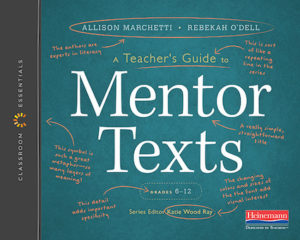All You Need to Select and Use Mentor Texts
A Teacher’s Guide to Mentor Texts: Grades 6-12
By Allison Marchetti and Rebekah O’Dell
(Heinemann, 2021 – Learn more)

Reviewed by Sara Pennington
Teaching writing is an often overlooked or underplanned piece of the Language Arts curriculum. How do we engage our students in writing in a way that gets them thinking about the writer’s craft and allows them to develop their skills with the support of those who have refined their craft?
Allison Marchetti and Rebekah O’Dell provide concrete and engaging methods for doing just that in A Teacher’s Guide to Mentor Texts.

Chapter Two provides a scaffolded process for helping students read like writers and consider how what they notice can be utilized in their own writing. Chapter Three focuses on craft, such as choosing the right word and meaningful word repetition, along with the strategic use of punctuation to add to meaning.
Text structure, such as powerful beginnings and endings and the use of transitions, is the focus of Chapter 4. Chapter Five focuses on genres of writing, ranging from free verse poetry to news articles. Chapters Six (Planning Instruction with Mentor Texts) and Seven (Assessing Students’ Work with Mentor Texts) provide the nitty-gritty how-to for implementing the ideas and strategies in the previous chapters within your own classroom.
There were many elements of this text that I will be referring to in my future practice. There are additional online resources, including templates for instructional planning and videos that walk through specific strategies mentioned in the text. The addition of these online resources definitely adds to the value of the text, particularly for those who wish to gain a deeper understanding of applying the ideas.
Selecting mentor texts for your students
The list of qualities of mentor texts provides a strong starting point for selecting mentor texts for your own students. According to Marchetti and O’Dell, mentor texts:
►Are engaging and relevant to your students. (What are your students’ interests? What is happening in their lives and the world around them right now?)
►Are professionally crafted. (The text is written so that it engages you as a reader and makes you want to dig in.)
►Inspire and guide. (Are full of new ideas, strategies, or structures that can be used to help your students develop their own craft as writers.)
►Take many forms. (Can be a single sentence, an article, or an entire book. A mentor text can also be multimodal, e.g. a podcast.)
►Are Accessible. (Is the mentor text something your students can engage with [read and discuss] successfully? If it is too long; do you need to chunk it?)
And there’s more, much more!
This text has a number of additional strengths for the classroom teacher. Throughout the book are examples of student work highlighting specific craft moves modeled from mentor texts. The authors also include galleries that spotlight specific elements of craft (Chapters 3 and 4) and characteristics of various genres with suggested mentor texts for each (Chapter 5).
Read an excerpt
from A Teacher’s Guide to Mentor Texts
about “starting small” with craft and punctuation
The mentor texts utilized throughout the book are diverse in genre and format, including news articles, opinion pieces, graphic novels, shorts stories, excerpts from novels, memoirs, and more. Authors of suggested mentor texts include Kwame Alexander, Mari Andrew, Jason Reynolds, Don Brown and Katherine Boo, among others.
A Teacher’s Guide to Mentor Texts is a valuable addition to any English Language Arts teacher’s professional library. The authors’ combination of a structured lesson approach, a range of suggested mentor texts, and an overall message to make texts relevant to your specific students resonates for teachers at multiple levels of experience.
Sarah E. Pennington taught middle school language arts for a decade before returning to school to pursue her doctoral degree in curriculum and instruction. She is currently an assistant professor at Montana State University, where she teaches pre-service educators the ins and outs of supporting young literacy learners. She also provides professional development in literacy and motivation to teachers across the nation.






























